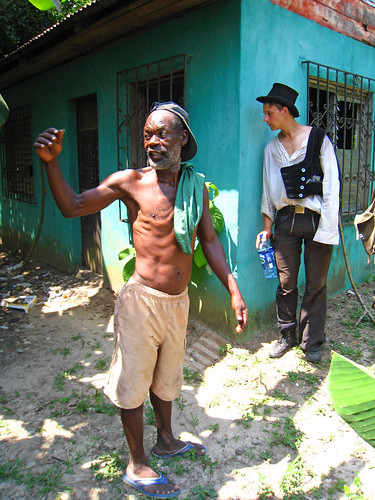Click on the photos for a larger view // Smellið á myndirnar til að sjá þær stærri
As soon as we got off the boat in Livingston we noticed that the culture is very different from what we had seen elsewhere in Central America. The mix of people is very eclectic. There are the black Garífuna, the indigenous Mayans that we had seen so widely in central Guatemala, other native Guatemalans of latino origin, and lastly the foreigners like us who have come to enjoy the laid back atmosphere. The walk from the dock to the town centre took about two minutes. At the Rio Dulce Hotel we were greeted by a very friendly Rastafarian who showed us around the one hundred year old building and found us a room on the second floor. Later that afternoon we took a walk around town and found that for the first time in a while we could walk around without being constantly hassled to buy something or give someone money. The town is not big but still there was plenty to see and do.
Um leið og við stigum á land í Livingston þá tókum við eftir því að menningin er mjög ólík því sem við höfum séð hingað til í Guatemala. Í Livingston er skemmtileg blanda af svörtum Garífuna, innfæddum Mayar sem við sáum svo víða í miðju Guatemala, öðrum latino heimamönnum og svo útlendingum eins og okkur sem hafa komið hingað til þess að njóta rólegrar stemmningar. Það tók okkur tvær mínútur að labba frá bryggjunni og í miðbæinn. Á Rio Dulce hótelinu tók mjög vinalegur Rastafari á móti okkur, sýndi okkur hundrað ára gamalt húsið og fann fyrir okkur herbergi á annari hæð. Seinna um daginn röltum við um bæinn og í fyrsta skipti í þó nokkurn tíma þá gátum við gengið um án þess að þurfa að hafna betlurum og hinum ýmsu gylliboðum. Bærinn er ekki stór en það var samt nóg að sjá og gera.
One bright sunny afternoon we decided to take a walk along the beach to the north of the town, to a spot called Los Siete Altares, which is a series of seven pools and waterfalls. We had been warned though that there was a shortage of water there at the moment but decided to take the five kilometre walk anyways with the attitude that it was more about the trip than the destination. The walk was a lot of fun as we passed by sandy beaches, through forests, and saw some locals playing and working by the seaside. All while enjoying the sunny day and a view of the beautiful Caribbean. When we reached Los Siete Altares it was even drier than we had imagined but they still charged us an entrance fee to look at the two remaining pools and the non-existent waterfalls. The walk back was just as pleasant although we were getting bit hot and tired. The only blight on the day was the unbelievable amount of trash that has collected along the coast. Everywhere there are piles of waterbottles, plastic containers, and, oddly enough, sandals and running shoes. While we had already been pretty appalled at the amount of trash everywhere in Central America, this was worse than anywhere else. We had expected less niceties than we are used to at home due to the poor economic situation in these countries but we hadn't expected the lack of respect for the environment that is evident all around us. Our fellow passengers on buses chuck their trash out the window without a second thought and no-one seems to be tasked with picking up any trash. It seems a shame with all the natural beauty on offer.
Eitt sólríkt eftirmiðdegi ákváðum við að rölta meðfram ströndinni norðan við bæinn að stað sem heitir Los Siete Altares þar sem eru sjö laugar og fossar á milli. Það var reyndar búið að vara okkur við því að það væri ekki mikið vatn þar í augnablikinu en við ákváðum samt að labba þessa fimm kílómetra með það viðhorf að þetta snerist meira um ferðalagið en áfangastaðinn. Gangan var mjög skemmtileg þar sem við gengum framhjá sandfjörum, í gegnum skóg og sáum heimamenn að leik og starfi við sjávarsíðuna. Og allan tímann skein sólin skært og við höfðum útsýni út yfir Karabíska hafið. Þegar við komum til Los Siete Altares þá var enn þá minna vatn en við höfðum haldið en við vorum samt rukkuð um aðgangseyri til þess að skoða þær tvær laugar sem voru eftir. Gangan til baka var síðan alveg jafn ánægjuleg þó svo okkur væri orðið heitt og þreytan farin að segja til sín. Eini svarti bletturinn á þessum degi var ótrúlegt magn rusls sem hafði safnast saman meðfram ströndinni. Alls staðar voru hrúgur af vatnsflöskum, plastílátum og, skringilegt nokk, sandölum og hlaupaskóm. Okkur hafði blöskrað allt ruslið sem er út um allt í Mið-Ameríku en hérna var það jafnvel verra en annars staðar. Við bjuggumst svo sem við minni þægindum og lúxus en heima hjá okkur vegna þess hversu illa stödd þessi lönd eru fjárhagslega en við bjuggumst ekki við því hversu litla virðingu fólk ber fyrir umhverfi sínu. Farþegarnir í rútunum henda rusli út um gluggann án þess að hugsa sig um og engum virðist falið að tína upp rusl neinsstaðar. Þetta er ótrúlega sorgleg umgengni við alla þessa náttúrufegurð.
That evening, as we were heading out to grab some food, we started talking to a local named Polo. He is Garífuna and was only too willing to share some details about his culture and his opinions on the world as a whole. Polo has traveled the world to play Garífuna music and was also very well read so our discussion was very interesting and enlightening. We discovered that the Garífuna are black Carib who are the original inhabitants of the area along with the Arawak indians. Our guidebook said they were the descendants of shipwrecked African slaves but according to Polo this is not true. Their culture has mixed with the Europeans and those African slaves who settled on the Caribbean islands. They have their own language that has drawn influence from French, Creole, Spanish and English. Polo explained to us how the division of the Garífuna across Belize, Guatemala, and Honduras has caused a division in their culture and a loss of some vital elements of their culture. One thing we discussed is how we were getting pretty tired of having to refuse the advances of overzealous salespeople and hustlers at every turn. In his opinion it is due to a lack of education and forward thinking. The hustlers only have a limited point of view and no concept of tourists as long term customers. It is all about getting all you can out of every single tourist, right now. We left Polo with a completely different understanding of the culture in the area; and a couple of CD's of his music.
Um kvöldið, þegar við vorum á leiðinni að fá okkur að borða, lentum við á spjalli við heimamann sem heitir Polo. Hann er Garífuna og var meira en til í að segja okkur frá ýmsu í sinni menningu og deila með okkur lífsskoðunum sínum. Polo hefur ferðast um heiminn til þess að spila Garífuna tónlist og er einnig mjög vel lesinn svo það var mjög áhugavert og upplýsandi að spjalla við hann. Við komumst að því að Garífuna eru svart Carib fólk sem sem hafa búið hér fyrir komu hvíta mannsins ásamt Arawak indjánum. Í bókinni okkar stóð að þeir væru komnir af Afrískum þrælum sem lentu í skipsbroti á svæðinu en samkvæmt Polo er það ekki satt. Menning þeirra hefur hinsvegar blandast við menningu Evrópubúanna og þessara afrísku þræla sem bjuggu sér heimili á eyjunum í Karabíska hafinu. Þeir hafa sitt eigið tungumál sem hefur orðið fyrir áhrifum af frönsku, creole, spænsku og ensku. Polo útskýrði fyrir okkur hvernig skipting Garífuna fólksins á milli Belize, Guatemala og Honduras hefur búið til skiptingar í menningu þeirra og ollið því að margir þættir hennar hafa tapast. Eitt sem við ræddum líka er hversu þreytt við erum orðin á að vísa frá okkur uppáþrengjandi sölufólki og hustlerum hvar sem við komum. Hann vill meina það að þessi hegðun sé vegna skorts á menningu og framsýni. Hustlerarnir sjá hluti frá einhæfu sjónarhorni og skilja ekki hvernig þeir gætu nýtt sér túristana til langs tíma. Allt snýst um að ná sem mestum pening út úr hverjum túrista, núna. Við skildum við Polo með mun betri skilning á menningunni á svæðinu; og með tvo geisladiska með tónlist eftir hann.
 |
| Polo, photo taken from here |
The whole time we were in Livingston we were expecting hurricane Richard to pass over the area. According to weather.com we were in a red danger area although the hurricane was always supposed to pass further north across Belize. We figured that the hundred year old house had withstood many a storm in its time and we should be safe there. Plus it stands on slightly raised ground and shouldn't be flooded. As it turned out our worries were needless. Richard passed over Belize City, which is pretty far north from Livingston, and the only effect it had on us was one afternoon of grey skies. In fact, the days in Livingston were among the sunniest we have had in a while.
Allan tímann sem við vorum í Livingston bjuggumst við við því að fellibylurinn Richard myndi fara yfir svæðið. Samkvæmt weather.com þá vorum við á rauðu hættusvæði þótt fellibylurinn ætti alltaf að fara aðeins norðar yfir Belize. Við hugsuðum sem svo að hundrað ára gamla húsið hefði staðið af sér nokkur óveður og við ættum að vera örugg þar. Það stendur líka á smá hæð og því ætti ekki að flæða vatn þangað. Það kom svo í ljós að allar áhyggjur voru að ástæðulausu. Richard fór yfir Belize City, sem er svolítið langt fyrir norðan Livingston, og einu áhrifin á okkur voru að eitt eftirmiðdegið var himininn ansi grár. Þessir dagar okkar í Livingston voru reyndar með þeim sólríkari sem við höfum fengið í svolítinn tíma.
Allan tímann sem við vorum í Livingston bjuggumst við við því að fellibylurinn Richard myndi fara yfir svæðið. Samkvæmt weather.com þá vorum við á rauðu hættusvæði þótt fellibylurinn ætti alltaf að fara aðeins norðar yfir Belize. Við hugsuðum sem svo að hundrað ára gamla húsið hefði staðið af sér nokkur óveður og við ættum að vera örugg þar. Það stendur líka á smá hæð og því ætti ekki að flæða vatn þangað. Það kom svo í ljós að allar áhyggjur voru að ástæðulausu. Richard fór yfir Belize City, sem er svolítið langt fyrir norðan Livingston, og einu áhrifin á okkur voru að eitt eftirmiðdegið var himininn ansi grár. Þessir dagar okkar í Livingston voru reyndar með þeim sólríkari sem við höfum fengið í svolítinn tíma.
















No comments:
Post a Comment